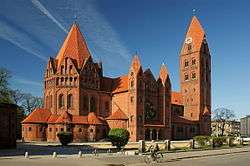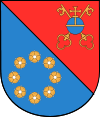Ostrów Wielkopolski
Ostrów Wielkopolski ([ˈɔstruf vʲɛlkɔˈpɔlskʲi]) (often abbreviated Ostrów Wlkp., formerly called only Ostrów, German: Ostrowo, Latin: Ostrovia) is a city in central Poland with 72,364 inhabitants (2018), situated in the Greater Poland Voivodeship; the seat of Ostrów Wielkopolski County. It is the fifth-largest city in the voivodehip after Poznań, Kalisz, Konin and Piła.
Ostrów Wielkopolski | |
|---|---|
 Skyline | |
 Flag  Coat of arms | |
 Ostrów Wielkopolski | |
| Coordinates: 51°39′N 17°42′E | |
| Country | |
| Voivodeship | Greater Poland |
| County | Ostrów Wielkopolski County |
| Gmina | Ostrów Wielkopolski (urban gmina) |
| Established | 14th century |
| Town rights | 15th century |
| Government | |
| • Mayor | Beata Klimek |
| Area | |
| • Total | 41.9 km2 (16.2 sq mi) |
| Highest elevation | 175 m (574 ft) |
| Lowest elevation | 123 m (404 ft) |
| Population (2018) | |
| • Total | 72,364 |
| • Density | 1,730/km2 (4,500/sq mi) |
| Time zone | UTC+1 (CET) |
| • Summer (DST) | UTC+2 (CEST) |
| Postal code | 63-400 to 63-417 |
| Area code(s) | +48 62 |
| Car plates | POS |
| Climate | Cfb |
| Website | http://www.umostrow.pl/ |
History

Recently, a small fortified dwelling dating from the 10th century was discovered on the north-east side of the town's limits. An archeological excavation is now in progress. It was part of Poland since the establishment of the state in the 10th century.
Ostrów received town rights in 1404 but the economic stagnation caused by fires, wars, and a weak 16th-century nobility, led to the town’s officials dropping its town status in 1711. Administratively it was located in the Kalisz Voivodeship in the Greater Poland Province of the Polish Crown. In 1714, one of the nobles of Ostrów, Jan Jerzy Przebendowski, intervened at the royal court, for the status to be reinstated. To help the city grow, new settlers were exempt from taxes for six years.[1] By the power of Grand Crown Marshal Franciszek Bielinski, the town received its status back with greater privileges. Another noble family, the Radziwiłł family took patronage over the town and looked over its many investments. The care of the town’s owners, work of its people, and dedication of its officials, as well as its location, favored the town’s continuous growth.
During the Second Partition of Poland, in 1793, the town was annexed by Kingdom of Prussia. Back under Polish rule as part of the short-lived Duchy of Warsaw between 1807 and 1815, it was re-annexed by Prussia, to be included within the initially autonomous Grand Duchy of Poznań in 1815. The cloth industry prospered in Ostrów until 1825, when Russia imposed tariffs on imported cloths, as a result of which many textile manufacturers moved east to the Russian Partition of Poland.[1] In 1828 local noble Antoni Radziwiłł funded the construction of a new town hall. In 1845 the Royal Catholic Gymnasium was established, a significant Polish school in the Prussian Partition of Poland,[1] which as the I Liceum Ogólnokształcące remains one of the most renowned high schools in Greater Poland. Ostrów then became an important center of Polish education, press and publishing in the region. Among the local Polish elites were Antoni Bronikowski, an outstanding Hellenist who translated the works of Plato, Homer, Thucydides and Xenophon into Polish, and poet Anastazy Cywiński.[1] The establishment of a railroad hub in Ostrów was a vital turning point in its development, helping to lend the town prominent status on the local and national scene. In 1875 the first railway connections were opened, with Poznań and Kluczbork.[1] The Primate of Poland Cardinal Mieczysław Halka-Ledóchowski was imprisoned in the local prison for two years by the Prussians, before they eventually expelled him from the country.[2] After Poland regained independence, he was honored with a monument in the city.

Ostrów was an important center of Polish resistance and national liberation movements.[1] One of the town’s historic episodes was the so-called Republic of Ostrów (Republika Ostrowska), which was the citizens’ upheaval of 1918. No blood was shed at that upheaval and all political powers were taken over from the Prussian authorities. The anniversary of the upheaval, November 10, is celebrated as the official Day of the City of Ostrów Wielkopolski.[1] The first Polish mayor of Ostrów after regaining independence was Stefan Rowiński, one of the leading independence activists and publishers in Ostrów before 1918.[1] In the interbellum, Ostrów was one of the fastest growing towns: the number of inhabitants doubled, showy houses were built, as well as new schools, stadiums and a swimming pool.[1] Three new villa district were founded, and a modern railcar manufacturing (Fabryka Wagon) began.[1] In 1934 the city limits were widely expanded and the villages of Stare Kamienice, Zębców, Wenecja and Krępa became new districts of Ostrów.
.jpg)
During the German occupation of Poland during World War II, a Nazi German labor camp, Staatspolizeistelle Litzmannstadt Arbeitserziehungslager Ostrowo,[3] operated within the town's limits, where 193 people died. The town was one of the major Polish conspiracy centers in the Great Poland region. In 1941, after the Gestapo's crackdown on the headquarters of the Poznań branch of the underground army Union for Armed Struggle-ZWZ, the headquarters were moved to Ostrów. From here the re-structure of the Poznań region of the Union was conducted. Ostrów was liberated from German occupation on January 23, 1945.[4]
After the war Ostrów Wielkopolski was part of the Poznań Voivodeship, and from 1975 to 1998 it was the second largest city of the Kalisz Voivodeship (behind Kalisz). In 1979 Ostrów's city limits were widely expanded for the second time, including the former villages Pruślin, Szczygliczka, Zacharzew, Piaski, Stary Staw and Nowy Staw as new districts.
Sights
Ostrów has a well-preserved city center, with such sights as:
- City hall (Ratusz) at the Market Square (Rynek), housing the local museum
- Ostrów Wielkopolski Co-Cathedral
- Virgin Mary Queen of Poland church
- I Liceum Ogólnokształcące, the city's oldest high school, and one of the most renowned high schools of Greater Poland
- Main Post Office
- Monument of Primate of Poland Mieczysław Halka-Ledóchowski
- Former synagogue
Places of interest outside the city center include:
- Old Cemetery (Stary Cmentarz), the oldest active Catholic cemetery in Poland
- New Cemetery (Nowy Cmentarz), opened in 1905, resting place of many distinguished figures of Ostrów, and Greater Poland insurgents, including the first fallen insurgent Jan Mertka
- Park 3 Maja (3 May Park)
- Park Miejski (Municipal Park)
- Ogród Bracki (Bracki Garden)
 City hall at the Market Square
City hall at the Market Square Ostrów Wielkopolski Co-Cathedral
Ostrów Wielkopolski Co-Cathedral.jpg) Virgin Mary Queen of Poland church
Virgin Mary Queen of Poland church- I Liceum Ogólnokształcące
 Main Post Office
Main Post Office- Facades of old townhouses in the city center
 Old Cemetery
Old Cemetery Graves of participants of the Greater Poland Uprising
Graves of participants of the Greater Poland Uprising Monument of Mieczysław Halka-Ledóchowski
Monument of Mieczysław Halka-Ledóchowski- Elementary School No. 2
 Former synagogue
Former synagogue.jpg) Park Miejski
Park Miejski
Education
- Społeczna Wyższa Szkoła Przedsiębiorczości i Zarządzania in Łódź, branch in Ostrów Wlkp.
- Technical University of Łódź, branch in Ostrów Wlkp.
Sports

- Stal Ostrów Wielkopolski – men's basketball team, second in Polska Liga Koszykówki in the 2017/2018 season
- Ostrovia 1909 Ostrów Wielkopolski – men's soccer team
- KM Ostrów Wielkopolski – speedway team
From 5 July to 20 July 2013 Ostrów Wielkopolski hosted the 17th European Gliding Championships. The local pilot, Łukasz Błaszczyk, took a bronze medal in the Club Class.[5]
Notable residents

- Ehrenfried-Oskar Boege (1889–1965) – German general
- Paweł Bryliński (1814–1890) – Polish folklore sculptor
- Mirosław Ferić (1915–1942) – Polish fighter pilot and flying ace for 303 Squadron during World War II
- Heinrich Graetz (1817–1891) – German-Jewish historian
- Jarosław Iwaszkiewicz (1894–1980) – Polish poet, essayist and writer (Letters from Ostrów)
- Bartłomiej Jaszka (born 1983) – Polish handball player
- Krzysztof Komeda (1931–1969) – Polish film score composer and jazz pianist
- Krzysztof Kwiatkowski (born 1971) – computer scientist, researcher, software developer; former Minister of Justice
- Moritz Landé (1829–1888) – German architect
- Krzysztof Lijewski (born 1983) – Polish handball player
- Marcin Lijewski (born 1977) – Polish handball player
- Władysław Marcinkowski (1858–1947) – Polish sculptor
- Władysław Markiewicz (1920–2017) – Polish sociologist
- Bernhard Rawitz (1857–1932) – German anatomist
- Manfred von Richthofen (1892–1918) – "Red Baron", German fighter pilot (World War I); briefly stationed in the city's cavalry unit before being sent to the Western Front
- Jan Żniniewicz (1872–1952) – Polish physician, author of the new method of hydrotherapy (balneological method of treatment of chronic rheumatic diseases)
International relations
References
- Witold Banach. "Historia kołem się toczy". UMOstrów.pl (in Polish). Retrieved 8 February 2020.
- Bernadeta Kruszyk. "Mieczysław Ledóchowski". Archidiecezja Gnieźnieńska (in Polish). Retrieved 8 February 2020.
- http://www.kalisz.eu/files/1227097539492405c35c3fd/Oboz_w_Ostrowie-_wyklad.doc
- Marek Weiss, Przed 73 laty w Ostrowie okupacja dobiegła końca, „Ziemia Kaliska”, No. 4, 2018, p. 10 (in Polish)
- Website of 17th European Gliding Championships
- "Brantford Expositor - City gets a twin". Archived from the original on 2012-07-23. Retrieved 2009-05-31.
